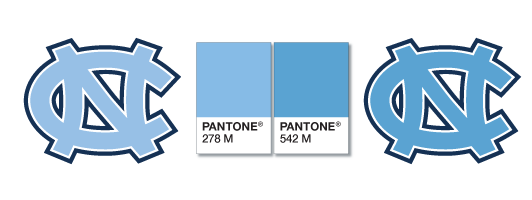
North Carolina fans might be singing the blues after losing the title game of the NCAA Men’s Basketball Tournament, but they can still stand proud as one of collegiate athletics’ most powerful brands. That’s because when they take the court, the UNC Tar Heels don uniforms that are instantly recognizable with their distinct blue color.
Other brands “own” colors within the marketplace. In soda, Coca Cola owns red, in shipping UPS owns brown, and in telecommunications T-Mobile owns magenta. No other collegiate teams (or brands) come to mind when you think of Carolina Blue, the light blue that is “not powder blue… not baby blue, either,” according to an article in the Wall Street Journal.
‘So what’s the big deal?’ you might ask. The big deal is that just last year a new standard “Carolina Blue” was established (Pantone® 542) for the entire University (gasp!), and one that matches the uniforms of UNC’s basketball team. While the “new” color might seem like a very subtle shift from the old (Pantone® 278), the reason for the change has to do with how students, alumni and fans experience the brand across different media—from online and mobile devices to ultra high definition television.

With higher resolution and increasing quality screens, we can see every minute detail of a game, from the expressions on the players’ faces to their sweat-soaked jerseys (which, incidentally, changes the color even more). We can even notice the discrepancies between the color of UNC’s uniforms and the color of fans’ shirts and face paint. Dean Smith, the legendary UNC basketball coach, noticed that his players’ uniforms looked washed out and gray on the very first color television sets, so he had them made in a more vivid color. Consistent color matters, particularly to a brand with such a rich heritage and history.
While it pains me to write an article about North Carolina (myself being a Jayhawk from the Roy Williams era of KU basketball), how the Tar Heels have adapted their blue to meet the needs of different media and viewing experiences is an excellent case study in the importance of color (and its consistent application) in branding.
By: Ryan Hembree, Principal | Brand and Creative Strategy